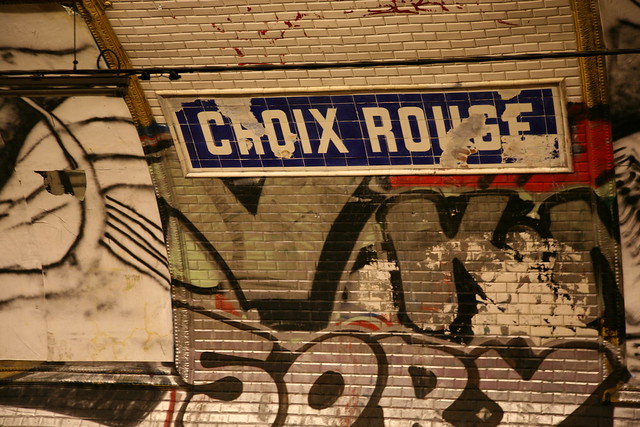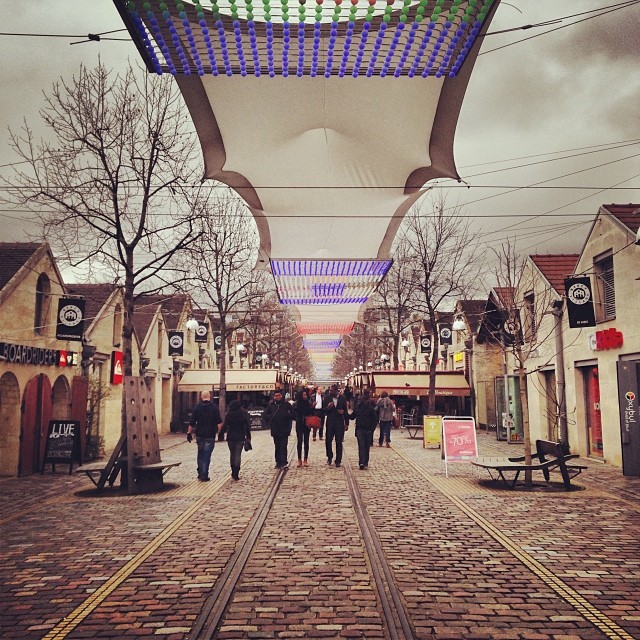Over the past few weeks, this blog has looked at a number of different ways in which Paris’s disused transport infrastructure has been given new life: as parks, museums and places of cultural significance and community spaces. Today I’ll be concluding the series with some other disused infrastructure and its use as restaurants, shops and offices.

Bercy warehouses
The area of Bercy, in Paris’s 12th arrondissement, was once home to a large area of warehouses used to store wine and liquor on its arrival in the city. However, by the mid-20th century, the neighbourhood was falling into disrepair. In the 1980s, it became the focus of a major regeneration scheme, with the construction of the Bercy Arena and the new Finance Ministry building. This was followed with the opening of the Parc de Bercy in the 1990s, and then, in May 2000, a new open-air shopping centre, using some of the old warehouse buildings and even leaving some of the complex’s rails behind. Called Bercy Village, it’s home to cafés, restaurants, shops and a cinema.

Les Docks de Paris
In the article on cultural spaces we looked at the Magasins Généraux of Pantin, vast grain storehouses on the Canal de l’Ourcq. The neighbouring town of Aubervilliers was also connected to the canal and rail networks, and had its own Magasins Généraux, storing such products as grain, sugar, vanilla and even opium. Business slowed from the 1950s onwards, but the buildings stayed standing. They now house Les Docks de Paris, a large convention centre comprising three different spaces.

Restaurants of the Petite Ceinture
Every post of this series has included the Petite Ceinture: this disused railway has spawned parks, music venues and community projects. It also houses several restaurants. Some of these, such as Poinçon and Le Hasard Ludique, I already mentioned in the post on cultural spaces. But there are more.
In the bourgeois 16th arrondissement, in the west of the city, stands a chic restaurant known simply as La Gare. This stylish red-brick building with full-height arch windows once housed the station Passy – La Muette. Now, its interior has been completely redecorated to accompany the cuisine of Peruvian chef Gastón Acurio. On the menu are dishes from around the world, including roasted and grilled meat and fish to share, tapas and dim sum. On the entrance level is a café/bar.

Before 1934 you could have travelled anticlockwise one stop to reach the Gare d’Auteuil-Boulogne, another station which is now a smart new restaurant: the Auteuil Brasserie. While the building itself is a little more muted in design, the interior is beautiful and the restaurant boasts a large, covered rooftop seating area.
Station F
The Halle Freyssinet was a vast trainshed receiving freight from the line into Austerlitz. Built in the late 1920s, it was impressive for its era thanks not only to its scale (310 m long, 72 m wide) but also its construction methods: its engineer, Eugène Freyssinet, was a pioneer of prestressed concrete, an invention he himself had worked on.

Everything has its time, and by the 1990s this building’s time as a goods station had come to an end. Its then-owners the SNCF proposed destroying it, but fortunately its historical status saved it. In 2011 it was listed as a monument historique, and in 2013 it was bought by telecommunications billionaire Xavier Niel, who oversaw a project to turn it into a startup incubator. The result, Station F, opened in 2017 as the largest of its kind in the world. Big names present at the incubator include Facebook, Microsoft, BNP Paribas, and higher education institutions such as HEC and Arts et Métiers ParisTech.

The Gare des Invalides
On the left bank of the Seine, at the northeastern corner of the Esplanade des Invalides, sits an impressive building emblazoned with the words “Air France”. But this label belies its history: it was once the site of a railway terminal.

Designed by Juste Lisch, the architect of several other Parisian stations including Saint-Lazare, the Gare des Invalides opened in April 1900, in time for that year’s Exposition Universelle (a month before the Gare d’Orsay a kilometre upstream along the Seine). This station initially ran a shuttle service to the nearby Champ de Mars, before the completion of the line to Versailles in 1902. From then on, passengers could board intercity services to Brittany and Normandy as well as suburban trains. But in 1935, mirroring the fate of the Gare d’Orsay, all long-distance traffic was redirected to Montparnasse, and 10 of the station’s 15 platforms were closed.
In 1946, Air France took over the site, opening an air terminal there for passengers to check in before taking a coach to Orly or Le Bourget. In 1949, they opened a restaurant, Chez Françoise, to serve waiting passengers. Thanks to its proximity to the National Assembly, this restaurant soon became a favourite of MPs, earning itself the nickname “la cantine des Parlementaires”. Although check-in was moved to the airports in 1961, the restaurant remains today, and is still frequented by politicians. The building also houses a museum dedicated to the history of the airline. Below ground, trains still run along the old line, continuing through into a tunnel built in the 1970s to create the RER C.
The future

Lisch was also the architect behind the Gare des Carbonnets, which was originally built at the Champ de Mars for a previous Exposition Universelle in 1878. Dismantled after the exhibition (a common practice at the time), it was reassembled in the northwestern suburb of Asnières-sur-Seine in 1897. In 1937 it ended its life as a station, and it has been completely abandoned since 1983. After almost three decades of neglect, it’s due to reopen in 2022 as a coworking space.
There are myriad plans afoot to convert other disused spaces. Some of these, including a restaurant on the underground platforms of a disused metro station, are part of public projects Réinventer Paris and Inventons la Métropole.
 Fabric of Paris
Fabric of Paris